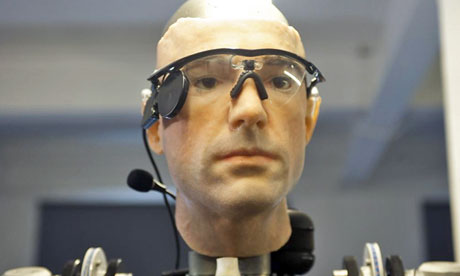How to build a bionic man
January 31, 2013

Rex (credit: Channel 4)
Rex the bionic man shows how close technology is to catching up with — and exceeding — the abilities of the human body, The Guardian reports.
Housed within a frame of state-of-the-art prosthetic limbs is a functional heart-lung system, complete with artificial blood pumping through a network of pulsating modified-polymer arteries.
He has a bionic spleen to clean the blood, and an artificial pancreas to keep his blood sugar on the level.
Behind the deep brown irises are a pair of retinal implants, giving him a vista of the crowds of curious humans who meet his gaze.
He even has a degree of artificial intelligence: talk to him, and he’ll listen (through his cochlear implants), before using a speech generator to respond.
The iLimb Ultra, of which Bertolt is a user, is part of the new class of myoelectric prosthetics. These custom-made devices function by placing electrical sensors directly in contact with the skin. These sensors pick up the signals generated by muscular movements in the residual limb — signals that are then translated by software into natural, intuitive movement in the prosthetic limb.
The Bionic Man’s pancreas was invented by Prof, Joan Taylor of De Montfort University. Within a protective casing of firm gel lies a store of insulin. In the presence of excess glucose, the gel begins to soften and liquefy, releasing the insulin – and as glucose levels drop in response to the insulin release, then gel hardens once again, in a self-regulating loop.
Like a natural pancreas, this device requires no conscious monitoring — implanted permanently within the body, it plugs directly into our own homeostatic systems, potentially liberating us from the chore of blood sugar monitoring. It is, Prof. Taylor hopes, only around seven years from general use.
Bionic Man’s kidney is, likewise, an implantable, self-regulating artificial organ. The brainchild of Prof. Shuvo Roy’s team at the University of California, San Francisco, it’s made up of a silicon nanoscale filtration system, which requires only the power of the body’s own blood pressure. The filtrate thus generated is then passed to a miniature bioreactor — a small cartridge housing living renal tubule cells from a healthy donor. Together, these components will, it is hoped, perform all the functions of a biological kidney. Clinical trials are due to begin in 2017.
It’s one thing to use a bionic organ to replace lost function. But in a future world where we could, feasibly, replace virtually all of our body, will we blur the boundaries of artificial and natural to an extent that we have to recalibrate our definition of self and non-self? That’s especially pertinent when we consider the reality of neural prosthetics, like the “memory chips” developed by Dr Theodore Berger.
What’s already certain, though, is that artificial body parts can already restore independence to us in a way never previously possible. Bionic Man is a visceral, visual way to show just much of our bodies could be replaceable in the near future. As a piece of engineering outreach, he is unique — and as a symbol of future humanity, he is startling.
How To Build A Bionic Man will be broadcast on Channel 4 on 7 February. The bionic man can be seen in a new free display in the Who Am I? gallery at London’s Science Museum from 7 February until 11 March